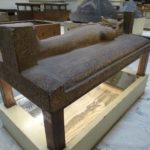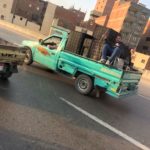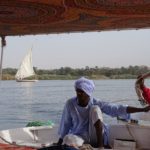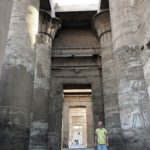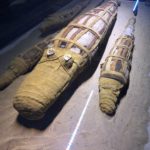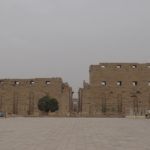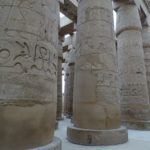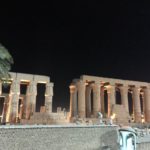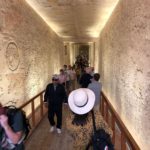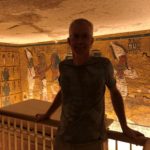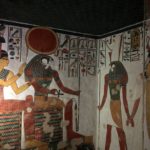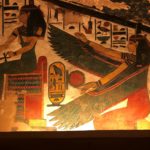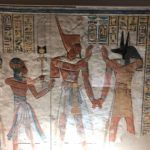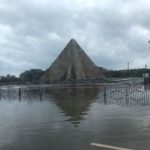Friday 6 March 2020. After checking in, into the city. Survive some very busy and crazy street crossings, traffic lights are decorative it seems. Cross the river Nile, walk under some palm trees at Al-Zohreiya Gardens and see the Cairo Tower. This afternoon the Egyptian Museum gives a glimpse of what Ancient Egypt has to offer. The museum has a huge collection, packed on the floors. Strangely the stony items can still be touched. Numberless sarcophagus, stone and wooden, one red granite one has a goddess carved inside the lid. Many statues, even some strange ones of Akhnaton. His wife Nefertiti has some heads here as well. Amazing wooden statue and carvings. Paintings out of the temples. Chairs, boxes, tools, everything. All 2000 to 4000 years old. Upstairs there’s more. The room with the golden mask of Tutankhamun is special. Lots of jewellery, the golden sarcophagus and more artefacts. Outside the room the huge wooden boxes with ornaments and gold plated. 4 boxes inside of each other. Alabaster pots with the mummified organs. Chairs with drawings, too much to mention. All found in the tomb of the young and unimportant Tutankhamun. Imagine the tombs of the great rules… Two unwrapped mummies are shown. 3500 years old, but the mummies look very ‘lively’.
Saturday, an early start for the most iconic ancient building in the world, the Great Pyramid of Giza. It’s huge and very impressive. Climbing the narrow tunnel and entering the Grand Gallery. A long hallway with a high ceiling. Then a narrow entrance to the red granite King’s Chamber with the granite tomb. All ready robbed in ancient times, but still cool to be here and realize there is a huge weight above me. Back outside we walk a bit further and see King Farouk’s Pyramids House. So many camels around for the touristic ride. Most skip the Solar Boat Museum. Too bad. Build over the pit where the boat was, the well preserved 44 m long cedar boat is on the first floor. Looks still almost new (being some 4000 years old). Enjoy the panorama view on the three biggest pyramids and some small ones. The Pyramid of Menkaure is the smallest, for the grandson, but the intention was to make the outside of red granite from Aswan, a thousand kilometres away. Last stop at this site is at the Sphinx, too touristy, but still good to see. Another visit to the Egyptian Museum and tonight we take the train to Aswan.
Sunday. The landscape around the river Nile is green and full of palm trees, some desert in the background. This morning a small boat takes us to the island with the Philae Temple. The story of Isis is told by guide Arafa and he tells the temple is moved to save it for the rising water after creating the dam. Most faces of the carvings are destroyed in ancient times and the Christians. Quite common in the past, but such a shame. Still an impressive sight. At 16 h we’re heading for the Nubian culture. We walk across the street and take a small boat to get around Elephantine Island, a small island in the River Nile. After the Aswan Botanical Garden old ruins with the Pyramid of Elephantine. We go all the way around and stop at the ferry place. Get off the boat and the local guide leads us through the Nubian village Koti on the island. Small streets without traffic, the gardens and fields. Some old men are drinking tea next to the coffee house and children saying hello. We enjoy the sunset with a view at Agha Khan’s Tomb. Have a beautiful dinner at a local family and the local cats have a meeting here as well.
Monday 4:15 h Carol, Debby, Elise and I are ready to go. Endless desert at both sides of the road. After two hours and the sunrise we stop for a coffee break. More desert, green areas near the channel and the biggest solar farm in the world will rise here, to provide Europe of clean energy. It’s almost 8 am when we arrive. Entering the site we see just a big pile of stone and sand. Walk around it and then the immense statues of Ramses II next to a the entrance. Too crowded, some 500 people in front, so visit the smaller one. The temple for the wife of Ramses II, Nefertari’s Temple of Hathor. Apparently Ramses II wrote some romantic words about her next to the statues of them. She was of course the most important of his many wives. Inside this temple nice hieroglyphs. Beautiful. Scenes with the gods. Then the Temple of Abu Simbel. Fewer people are here now and we can enjoy the interior. Amazing detailed hieroglyphs and images of Ramses II conquering his enemies. Again more gods and more war drawings. Very overwhelming. After the two hour free time we see the museum about how they moved the temple 200 m to rescue it from the artificial lake rising in the ‘60 because of the 110 m high dam. Visit the Aswan quarries with the unfinished obelisk. The quarry is not that big but the obelisk is huge. A big block of red granite, 42 m long and 2 to 2 m is laying in the quarry. It has some big cracks, so they left it. But imagining how they get this huge heavy block out of the quarry and on a boat to Cairo or Luxor… Unbelievable. We take the shortest route to the river and that’s through a residential area. A lot of waste on the streets, children and people say hello and are surprised to see four white people in their streets, but very friendly. As we arrive at The Old Cataract, the hotel where Agatha Christie road some of her books, it’s around 5 pm. A beautiful classy hotel. On the terrace we enjoy the beautiful sunset.
Tuesday our transport is two felucca’s, traditional sailing boats. The wind and weather are perfect and we can enjoy the trip so much. Laying down in the shade and watching the shores of the river. Luckily no other boats on the river at this time of the day. Beautiful. Stay the night on the boat and next morning visit Kom Ombo. An impressive empty temple. Some of the columns and ceilings have still colours. Like Abu Simbel, the temple was hidden under the sand and this is why it’s quite good preserved. Beautiful hieroglyphs, but most of the faces are chiselled out of the walls and columns. Apparently the Christians used this temple as a church and as a hobby they destroyed the faces of the ancient gods and kings. The column fields and on top some stone ceilings are amazing. With all the colours in the past, it must have been an overwhelming complex. Next door the Crocodile Museum. The temple of Kom Ombo was for the Crocodile God and in that time they mummified crocs. Even some big ones. The location of our hotel in Luxor is perfect with a view of the Temple of Luxor. In the afternoon we pay a visit to the Karnak Temple. We enter the huge complex from the westside. Walkthrough two 20 m or so high Pylons. At the back of the right one, there is still a ramp of mudstones. This temple was never finished and some of the columns are still bricks. Had to be formed jet. Then two rows of columns, the colonnades, and the temple of Sethos II and Temple Barque Chapel of Ramses III. The second Pylons mark the next step and we enter the most impressive part, the Great Hypostyle Hall. A big hall of 53 to 103 m2 with a forest of columns, 15 m high with (partly) a stone ceiling. Hieroglyphs everywhere. Still some colour. You feel so small in this enormous hall and so impressive they built it millenniums ago. The third Pylons lead to the Amenhotep III Court with two huge red granite obelisks. The 4th Pylons mark to the Wadjet Hall and the 5th Pylons a big court and the Chapel of Tuthmosis III. With the ladies, I explore the rest of this complex. Walk along the sacred lake to the Cachette court and the 7th to 10th Pylons. At the last Pylons, the guard wants to show something and take pictures. Like always to ask some money. Here the sphinx alley starts and goes all the way to the Temple of Luxor in town. About 2,5 km with at both sides a sphinx every 5 m or so. Next is the Gateway of Ptolemy III Eurgetes. Again a guard wants to make some money, but we take our own pictures. He walks with us to the Opet Temple and the Temple of Khonsu. Tells about it and opens the door to some rooms with nice colourful wall and ceiling paintings. Beautiful. His boss shows up and leads us on the stairs to the top so we have a view over the complex. A small tip for both, back to the main complex and enjoy the column hall again.
A new day exploring. After one and half hour we arrive in the dusty mountains. This valley has just sand and rocks. At the moment a sand storm is coming and the air is misty. But before we stopped at the Colossi of Memnon. Apparently this complex used to be even bigger than Karnak. Now just some statues and pieces of stone are left. Back on the bus to our next destination in the mountains. A short 300 m train ride to the starting point. Against the mountain, a big temple with 3 floors awaits us, the Mortuary Temple of Hatshepsut. Rows of columns in the facade, some statues looking over the valley. Beautiful again. Back to the bus and to our main goal. Luckily it’s not crowded at all. We’re in the Valley of the Kings and visit several tombs. The sand storm makes the place even more mystical. First, we visit the tomb of Ramses IV. Second is the tomb of Tutankhamun. A small tomb for a young king, but very well known. We saw some of the artefacts they found in the Egyptian Museum back in Cairo. The room is decorated with colourfully painted hieroglyphs and the mummy of Tutankhamun is in the tomb as well. Next is the tomb of Rameses V and VI. A bigger tomb, well decorated. And of course, you can take pictures, just for a small tip to the guard. Now I’m the man of the family and have to tip. More into the valley we visit the tomb of Ramses III and the tomb of Merenptah. This tomb is going deeper into the mountain and with stairs. Beautiful paintings again. All so amazing. Have lunch with a local family in the village near the Nile. Fantastic food, all fresh and tasty. At the Nile we see our hotel on the other side. Half of the group takes the boat back to Luxor. At first, it seems there are no boats crossing anymore. But luckily after some negotiation with the water police the boats go. With my new exploring family, I explore the Valley of the Queens. The sand storm colours the sky and the sight is reduced even more than the morning. Again a valley of sand and rocks. First, the workers’ tombs and village where they lived and see how beautiful the bright colours in the tombs of the workers still are. They kept the best for themselves it seems. Next is the Valley of the Queens. Visit three colourful tombs and the restored tomb of Nefertari. It took ten years, but it shows. Inside the tomb of the beloved wife of Ramses II the colours are very bright. Normally you can stay only ten minutes inside. Nobody is here and when we’re inside there’s a power failure. The guards use the flashlights and show us the beauty of the tomb. Many photo opportunities. Of course, we can step over the cord to take the perfect picture. See this one and this. Maybe another picture with the family. Amazing beauty and so many details and bright colours. Then the power is on again. But actually the tour with the flashlight felt like exploring ourselves. Unforgettable. The sandstorm increases and at the time we’re in the hotel it is a real storm. Have dinner in the hotel and get our stuff. At 19:30 h we leave to the airport, it’s not clear when the flight will take off. It changes to 7:30 am and we have to stay the night at the airport playing games. In the morning a known face shows up at the airport, dr Nasr, the famous Egyptologist. He also had to stay the night at the airport, but in the VIP-room. The weather changed and it’s quite calm now. The plane takes off and after one and a half hour we land in Cairo. Change flights for tomorrow. Because of the Coronavirus many countries closed their border. Luckily I can book a direct flight to Amsterdam. The streets in Cairo are flooded and traffic is slow. With David and Jay, the last to stay, I enjoy a few beers and the flight to Amsterdam the next day.
Being at the famous spots of Ancient Egypt, which I saw already on the television as a kid, imagining how they build it millenniums ago, in good company, was a lifetime experience.


